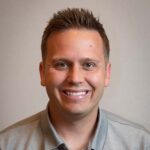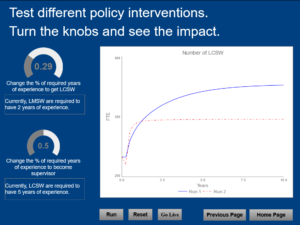Helping the helpers: Researchers use computer modeling to solve human problems
It’s not surprising that social work — a field steeped in systems theory — overlaps with system dynamics, which seeks to understand and model complex systems. But can computer modeling help identify solutions for and impediments to expanding the social work workforce?

Assistant Professor, Brigham Young University School of Social Work
A team of researchers led by Cole Hooley, Ph.D., LCSW, is going to find out. Hooley; Katherine Marcal, Ph.D., MSW; and Gabby Cunningham, Ph.D., MBA, are embarking on a research project funded by ASWB to apply system dynamics to a model of the social work workforce pipeline. They hope their model will help analyze and anticipate the impacts of changes to licensing requirements on the workforce.
“In the spaces that social work is engaged in, the problems that we’re trying to tackle are complex. … It’s not linear in the sense that if we just flip this switch then we know for sure this light goes on,” Hooley explains. “When it comes to social problems, sometimes you flip the switch and the light goes on, then the blender starts and you’re like ‘What? We didn’t want that! We wanted the light on!’”
In the spaces that social work is engaged in, the problems that we’re trying to tackle are complex. … It’s not linear in the sense that if we just flip this switch then we know for sure this light goes on.
In other words, complex systems often don’t respond to interventions in a linear way. Confounding factors, feedback loops, and interlocking mechanisms can either reduce or amplify the intended outcome or lead to a seemingly unrelated outcome that no one anticipated — the dreaded unintended consequence.
System dynamics uses a set of tools that let researchers build computer models of complex systems so that interventions can be tested in a low-cost way, illustrating any unintended consequences or nonlinear effects before the intervention is applied. Using a graphical computer interface, the simulations let users “turn the dials” on multiple inputs and see how varied factors influence the outcomes.
Hooley and Marcal have used this approach to build computer simulations that anticipate the effects of interventions in services to people without housing, factors that affect rates of adoption, and the impact of changes to supervision requirements on the social work workforce.
For the current project, Hooley, Marcal, and Cunningham are collaborating on research titled “Understanding the impact licensing policies have on scaling-up the social work workforce and mitigating harm.” They are hoping that their model will provide regulators with tools to project the possible impact of changes to licensure policies on the social work workforce and to project the changes to licensure complaints that serve as a proxy for public harm.
To build a comprehensive model that considers both qualitative and quantitative inputs, the researchers will work with data sets from the Utah Division of Professional Licensing, where Cunningham serves as the policy and research manager. A chance encounter at a meeting between Hooley and Cunningham’s supervisor set the collaboration in motion when Hooley realized that Utah’s data would be a good starting point for a simulation. “As far as comparisons to other states, [Utah] is a good case study. … We’re having among the hardest times reaching the population [that needs clinical social work services] in a meaningful way,” Hooley says. The Division of Professional Licensing will provide anonymized data looking back five years at masters and clinical licenses issued in Utah, along with the history of disciplinary actions. That data will inform the researchers’ model and serve as something of a natural experiment since the state recently made changes to the licensing requirements. Utah legislation eliminated the exam requirement for masters licenses and reduced the number of supervision hours for the clinical license.

The researchers hope that their model will prove useful for other jurisdictions. Hooley anticipates that this comprehensive data set will reveal patterns in the simulation that can be generalized to other regions. “What would be nice is to do this [in Utah], get it working, and then expand regionally, and start adding data from other sources,” Hooley says. The project also supports ongoing state efforts to bolster the behavioral health workforce in Utah, which has the highest prevalence of adult mental illness and serious suicidal thoughts in the United States.
Simulations of complex problems like the impact of regulation on the workforce pipeline can provide a cost-effective way to test hypotheses and allow stakeholders to see how interventions will play out before investing time and funding in solutions that may not work as expected. “In traditional research, getting funding to say ‘We’re going to do this study, we think it’s really good, we’re just going to need a hundred million dollars so we can get it to everyone in the U.S.,’” Hooley says, will only help to determine whether the intervention will work at scale or can even be implemented at scale. Hooley points out that system dynamics can help with that scale-up problem.
“In this virtual space, we can flip a switch and twist a dial,” Hooley says. “It allows us to do these sorts of conceptual experiments. … Sometimes it’s quite revealing — even after throwing in a hundred percent efficacy and tons of money and tons of people, there’s something about [a model] that flatlines and we’re still not reaching [the population in need of services]. And then we can come back and tweak things and play with things and investigate it more so that when we do want to move forward with a big solution, we have more confidence than if we just went off our best-laid hopes.”
This modeling work and system dynamics, in general, dovetail with Hooley’s broader research on scaling up mental health services. Hooley serves as an assistant professor at Brigham Young University, where he teaches clinical coursework and focuses on research dissemination and implementation science using system science methods.
“The big thrust of my work,” Hooley explains, “is ‘How do we get what works to everyone who needs it, equitably and rapidly?’ … We have so many brilliant minds that come up with a thing that can solve or reduce or improve, and then it becomes a problem of ‘Who gets that?’ And so my work looks at how do we get the [solution] out there? And system dynamics is so helpful, and the collection of approaches that fall underneath that umbrella .have been really helpful for my work.”
He opted to pursue a research-focused Ph.D. in social work at the Brown School at Washington University in St. Louis after working for several years as a clinical social worker. “I knew that I wanted to help the helpers,” Hooley says. “There was just this sense of ‘I’ve been on the front lines for a period of time, [and] there are so many heroes, not only on the provider side, but on the recipient side, too,’” he explains.
Hooley describes his social work career as guided by serendipity. As part of his first introductory social work class as an undergraduate at BYU, Hooley completed volunteer work at a bereavement center for families. He met the organization’s founder and was immediately impressed. “I’m like, ‘Who are you? I want to be like you,’ and she was a social worker.” He volunteered in a mentoring program for at-risk youth and talked to that program’s founder who was another social worker. Later, he encountered a woman who worked at a shelter for teenagers experiencing homelessness. “I’m like ‘I want to be like you,’ and she said ‘oh, I’m a social worker.’” He opted to complete his bachelor’s degree in social work, rather than education, as he’d originally planned. “It just opened up my whole mind to possibilities,” Hooley says, and he went on to complete an MSW at Smith College School for Social Work before earning his clinical license.
He later found a mentor in Enola Proctor, Ph.D., MSW, at Washington University, where he received a research fellowship. “The area of research was in mental health services, research dissemination, and implementation science,” he says. “I didn’t go in necessarily thinking scale-up was where I wanted to land. I just helped the helpers.”

